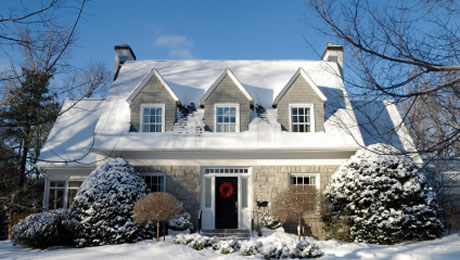Snow Removal Tips for Winter

Last year’s brutal Polar Vortex may be just a memory, but with winter almost here, it’s time to take a few precautions. Homeowners in snow prone regions such as the Northeast and Midwest are all too familiar with the destruction heavy snows and lingering ice can cause. Structural damage from expanding and contracting snow and ice as it goes through the freeze/thaw process can compromise siding, shingles, gutters, walkways, and pipes. All too often these situations lead to leaks, water damage, plus mold and mildew. Not to mention the fact that these winter storm repairs could cost you quite a lot of money.
In addition to keeping gutters free and clear, wrapping pipes and tracking down a trusty snow shovel, there are a few other tactics to consider.
Should you invest in a snow blower?
Snow blowers have come a long way in the last 20 years. New models are lightweight and much more portable. Most homeowners choose single-stage models which are very easy to use because of their handy size. While they are not built for thick accumulations of packed snow or ice, they are ideal for getting rid of wet, heavy snow. Most have a rubber edge made to bore along the top edge of pavement and curbs. However, they can not be used on gravel.
For larger areas such as wide driveways, decks and patios, a two-stage snow blower works well. Along with the boring action that breaks up large chunks of snow, these models are usually self-propelled and have an impeller that flings the white stuff out of the way. They also work on gravel.
For large areas where substantial drifting may occur, a lawn tractor with a snow blower attachment is the way to go.
De-icers and anti-icers
Ice can form quickly and be difficult to deal with because of the way it freezes and adheres to whatever is beneath it. After using a snow blower, many homeowners have to next figure out how to handle the potentially dangerous icy stuff underneath the snow.
The key is to prevent the ice from bonding with whatever is below. Keep in mind, this does not pertain to grass, but the materials that walkways and steps are made from. Chemical de-icers or anti-icers are the best way to tackle frozen slippery messes left by Jack Frost. These products are first applied to surfaces before the winter weather arrives. They act as a shield or barrier and prevent icy bonds from forming which makes snow removal much easier.
The most well known de-icer is rock salt. Although it has been widely used for decades, its popularity has waned because of the environmental and structural harm it can do. When not used carefully, distributing rock salt near plants can put them in jeopardy. Since concrete is porous, using rock salt on ice can cause pits in the cement. The safest way to use rock salt as a de-icer is to sprinkle it as soon as the frozen precipitation begins to fall, instead of after.
Anti-icers are chemical agents and should be applied before the snow or sleet begins to fall. These types of chemicals keep the snow and ice from bonding to the surface of driveways and walkways.
Snow melting systems – do they really work?
If severe winter weather is a given, installing hi-tech snow melting systems beneath the surface is a proven winner. Some of these devices involve burying cables underneath the areas where driveways and walkways will be built. Known as hydronic systems, they circulate a warm fluid that prevents snow and ice from adhering to the surface. Another solution is an infrared system. They are above the ground and use mounted quartz lamps that aim heat at targeted surfaces. Others that are more affordable and less complicated to install are electric heat-conducting rubber mats that efficiently melt snow and ice. Although all of these options are more expensive than a snow shovel or big bag of rock salt, they work quite well.
To read more about these and figure out which ones would work best for your home, here is a link to the website for the heating company, Warmly Yours.
Subscribe To Our Newsletter
Sign up with your email address to receive news and updates.